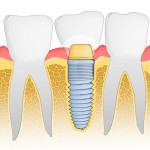
One concern during the immediate placement of dental implants is the preservation of buccal bone during post-extraction bone remodelling. Anatomical factors such as the width of the alveolar process and thickness of buccal bone are considered important as is the raising of a mucoperiosteal flap. Studies have suggested a negative effect of flap surgery on buccal bone remodelling compared to a positive impact for flapless surgery.
The aim of this review was to compare immediate implant placement using flap or flapless surgery.
Methods
A protocol was registered with the PROSPERO database. Searches were conducted in the Cochrane, Embase, PubMed, Web of Science and ClinicalTrials.gov databases. This was supplemented by searches in the journals, Journal of Clinical Periodontology, Journal of Periodontology, Clinical Implant Dentistry and Related Research, Clinical Oral Implants Research, Clinical Oral Investigations, International Journal of Oral & Maxillofacial Implants, International Journal of Oral & Maxillofacial Surgery. Two reviewers independently selected studies extracted data and assessed quality of the included randomised controlled trials (RCTs) using the Cochrane risk-of-bias tool (RoB 2). Clinical studies in systemically health patients age a least 18 years of age comparing immediate implant placement using flap or flapless surgery and published in English were considered. The primary outcome was horizontal buccal bone change with implant survival, vertical buccal bone change, pain, and clinical and aesthetic parameters as secondary outcomes. meta- analysis was performed for outcome variables that were reported in three or more included papers. Continuous outcomes were expressed as mean difference (MD|) and 95% confidence intervals (CIs) and dichotomous outcomes as risk ratios (RR) with 95% CIs.
Results
- 5 RCTs involving a total of 140 patients (140 implants) were included.
- Follow up ranged from 6 to 12 months.
- 4 studies reported on implants placed in anterior maxilla with just one study including mandibular sites.
- Two studies were considered to be at low risk of bias and 3 studies at high risk.
- 3 RCTs (flapless: 40; flap: 41) reported on horizontal buccal bone change (measured using CBCT) with a meta-analysis showing a mean difference of 0.48 mm (95% CI: 0.13mm to 0.84mm), favouring flapless surgery.
- 5 studies reported on implant survival with 2 failures reported (1 flap, 1 flapless), RR= 1.0(0.93 to 1.07).
- 2 studies reported on vertical bone change with results favouring flapless surgery.
- Post-operative pain was reported in 2 studies – rates were low in both groups by lower in the flapless group.
- Clinical and aesthetic outcomes were only reported in a single study.
Conclusions
The authors concluded: –
Based on CBCT data, flapless immediate implant placement resulted in more buccal bone preservation. However, the clinical relevance of this finding is unclear, since clinical and aesthetic outcomes were underreported.
Comments
The authors registered their protocol on the PROSPERO database and undertook a searched of a good range of databases. Only 5 small RCTs with a relatively short follow up period (3 trials of 6 months and 2 of 12 months) were included. In addition, 3 of the 5 included studies were assessed as being at high risk of bias. While a meta-analysis of the main outcomes of horizontal bone loss suggested a benefit in favour of flapless surgery it may not be clinically important. Well conducted and reported RCTs of appropriate size and duration would be needed to clarify the benefits of one approach over the other as the evidence is currently uncertain. Any studies should also include relevant patient reported outcomes.
Links
Primary Paper
Pitman J, Christiaens V, Callens J, Glibert M, Seyssens L, Blanco J, Cosyn J. Immediate implant placement with flap or flapless surgery: A systematic review and meta-analysis. J Clin Periodontol. 2023 Jun;50(6):755-764. doi: 10.1111/jcpe.13795. Epub 2023 Mar 5. PMID: 36843361.
Other references
Dental Elf – 9th Jul 2014
